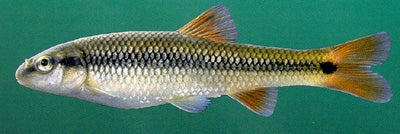RIVER CHUB
SCIENTIFIC NAME: Nocomis micropogon
CHARACTERISTICS: Compared to the bluehead chub, Nocomis leptocephalus, which is stout and whose breeding males become blue, the river chub, N. micropogon, is less stout, and its breeding males become rosy red. The river chub’s caudal, anal, and dorsal fins are reddish orange, while its paired fins are yellowish. Non-breeding individuals are olive above and dusky yellow below. Lachner and Jenkins (1971) report that mean values for meristic characters are higher in N. micropogon than in N. letocephalus.See Cope (1865a) for original description.
ADULT: 3.5 to 7.1 in (90 to 180 mm)
DISTRIBUTION: This species is found above the Fall Line in Atlantic slope drainages from the Susquehanna River south to the James River. It also occurs in the upper Santee, Savannah, and Coosa river drainages, throughout the Great Lakes area and the upper Ohio basin, and in the Tennessee River drainage. It is restricted to the upper Coosa River system in the Mobile basin, and it is only sporadically found in the Tennessee River drainage in north Alabama.
HABITAT AND BIOLOGY: The river chub prefers small to medium- sized streams of moderate gradient and clear water over substrates ranging from gravel to boulders. Like N. leptocephalus, N. micropogon is a nest builder, constructing gravel mounds up to 3 feet (914mm) wide and 12 inches (300 mm) high. During nest building, which occurs from late spring to early summer, males construct trenches for mating at the upstream end of the mounds (Jenkins and Burkhead, 1993). During the breeding season, male Nocomis develop a curious morphological feature called a nuptial crest. Swelling begins between the nares on the top of the head and eventually extends to the back of the nape, where it ends abruptly (Lachner, 1952). Lachner reports first spawning at three years of age and a life span of up to five years. River chubs feed opportunistically on immature aquatic insects, worms, crustaceans, mollusks, and fishes found near their bottom habitats.
ORGINAL DESCRIPTION: Cope described the river chub in 1865.
ETYMOLOGY:
Nocomis from Longfellow’s Song of Hiawatha, meaning "daughter of the moon."
Micropogon means small beard, referring to the small barbells.
The copyrighted information above is from Fishes of Alabama and the Mobile Basin.






